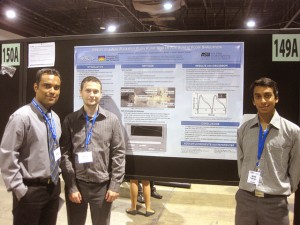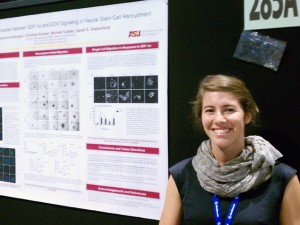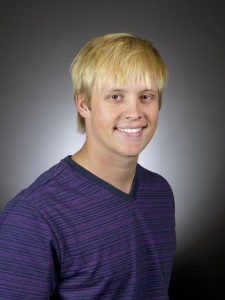
Engineering students’ research in spotlight at major biomedical conferences

From left, Rafeed Chaudhury, Victor Atlasman and Girish Pathangey exhibited their work aimed at finding better ways to treat vascular diseases.
Posted November 13, 2012
Recent international biomedical conferences provided a showcase for research being done by several students in the Ira A. Fulton Schools of Engineering.
At the Biomedical Engineering Society meeting in Atlanta, biomedical engineering doctoral student Rafeed Chaudhury teamed up with senior electrical engineering major Victor Atlasman and sophomore biomedical engineering major Girish Pathangey to present their work on a design for a new pulsatile flow pump system for aortic flow simulation.
It involves a piston pump that can read and replicate customizable aortic waveforms, and achieve flow rates almost three times higher than what is currently available on the market at a substantially lower cost, Chaudhury says.
“This new flow pump system will allow us to better understand transitional flow physics in the aorta, which may lead to advancements in the ability to treat vascular diseases, design medical devices and revolutionize surgical planning and predictive medicine,” he says.
Chaudhury’s advisers are David Frakes, an assistant professor in the School of Biological and Health Systems Engineering and the School of Electrical, Computer and Energy Engineering, and Ronald Adrian, a professor in the School for the Engineering of Matter, Transport and Energy.

Caroline Addington presented details of her research to use stem cells to treat people who sustain traumatic brain injuries.
At the same conference, Caroline Hom, a senior biomedical engineering major and Fulton Undergraduate Research Initiative Fellow, presented her work on a project titled Synthetic Biology and Bioinformatics for Predictable Control of Therapeutic Genes. Her adviser is Karmella Haynes, an assistant professor in the School of Biological and Health Systems Engineering.
The research involves transcription factors, which are proteins that regulate gene expression. Haynes developed a synthetic transcription factor, called Pc-TF, which binds onto genes that have H3K27me3-associated regions – a characteristic that normally restricts access of transcription factors to DNA – to reactivate dormant genes for cancer treatment and tissue regrowth.
“The work I presented entailed the formulation of an efficient, effective and broadly applicable procedure for using bioinformatics – the study of methods for storing, retrieving, and analyzing biological data – to predict the effect of synthetic transcription factors, such as Pc-TF, on gene expression and cell physiology,” Hom says. “Currently, I am expressing Pc-TF in three different cancer cell lines to confirm the validity of my procedure.”
Biomedical engineering doctoral student Caroline Addington, working under the direction of Sarah Stabenfeldt, an assistant professor in the School of Biological and Health Systems Engineering, is involved in research focusing on developing a regenerative repair strategy for people who have incurred traumatic brain injuries.
Her goal is to “to modify a population of neural stem cells so that they may be more efficient and effective at repairing damaged tissue after a traumatic brain injury.”
At the conference she presented an experiment to examine “the combined effects of extracellular matrix components and a specific signaling molecule, SDF-1α, on neural stem cell migration and transformation into cells of the central nervous system.”

Christopher Workman’s research focuses on advancing treatment of cerebral aneurysms. Photo: Jessica Slater/ASU
The experiment reveals there is a synergistic effect on neural stem cell migration between certain extracellular matrix substrates and SDF-1α, and that transformation into neurons was enhanced and more widespread in the presence of SDF-1α.
In the future, Addington says, this data will be used to enhance neural stem cell sensitivity to SDF-1α.
Christopher Workman, a junior biomedical engineering and biochemistry major, presented his work at the International Conference of the Engineering in Medicine and Biology Society in San Diego. The society is part of the Institute of Electrical and Electronic Engineers.
His project is Classification of Cerebral Aneurysm Fluid Dynamics Using Idealized Models of Varying Parameters. Frakes is the leader of the project and biomedical engineering doctoral student Justin Ryan co-authored a paper on which Workman’s conference presentation was based.
The research is aimed at improving treatment of cerebral aneurysms, which “now affect two percent of the population, cause 14,000 deaths each year in the United States and are treated unsuccessfully 50 percent of the time,” Workman says.
His project involves “designing idealized models of the sac-like lesions in the arteries of the brain and building them into transparent, hollow models,” he explains. “Fluid is run through those models to analyze how it flows in comparison to anatomical models, so that treatment can be based on a classification system using the geometries of the aneurysms.”
Media Contact:
Joe Kullman, [email protected]
(480) 965-8122
Ira A. Fulton Schools of Engineering



































